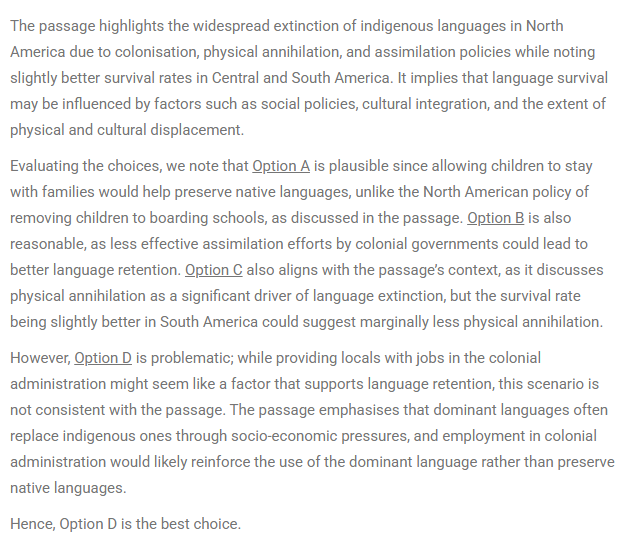CAT RC Questions | CAT RC- Social Science questions
FundaMakers is the Best CAT Online Coaching In India. Now prepare for CAT anytime with FundaMakers. We provide well-ordered syllabus coverage for both offline and online CAT preparation batches. FundaMakers brings to you the power-packed, well-structured CAT previous year question bank with more than 4000+ CAT Past Year questions. In the VARC section, one of the most frequently asked questions is from the topic- Reading Comprehension. Reading Comprehension turns out to be an important part of the VARC section from which over 60-70% of the questions are based on RC in the CAT Exam.
FundaMakers as a team has taken a painstaking step to bring you all the video solutions of the Reading Comprehension asked in the Previous Year CAT exam. CAT question bank offered by FundaMakers is a power-packed topic-wise compilation of the entire CAT previous year questions. Questions from the Reading Comprehension topic are some of the most scoring questions in the VARC section. To maximize your CAT score make use of FundaMakers CAT Question Bank. “Questions from CAT previous years” examination papers have been incorporated. Let’s get started with CAT Past Year Reading Comprehension Questions.
Comprehension
Directions for the questions: The passage below is accompanied by a set of questions. Choose the best answer to each question.
Languages become endangered and die out for many reasons. Sadly, the physical annihilation of communities of native speakers of a language is all too often the cause of language extinction. In North America, European colonists brought death and destruction to many Native American communities. This was followed by US federal policies restricting the use of indigenous languages, including the removal of native children from their communities to federal boarding schools where native languages and cultural practices were prohibited. As many as 75 percent of the languages spoken in the territories that became the United States have gone extinct, with slightly better language survival rates in Central and South America . . .
Even without physical annihilation and prohibitions against language use, the language of the "dominant" cultures may drive other languages into extinction; young people see education, jobs, culture and technology associated with the dominant language and focus their attention on that language. The largest language "killers" are English, Spanish, Portuguese, French, Russian, Hindi, and Chinese, all of which have privileged status as dominant languages threatening minority languages.
When we lose a language, we lose the worldview, culture and knowledge of the people who spoke it, constituting a loss to all humanity. People around the world live in direct contact with their native environment, their habitat. When the language they speak goes extinct, the rest of humanity loses their knowledge of that environment, their wisdom about the relationship between local plants and illness, their philosophical and religious beliefs as well as their native cultural expression (in music, visual art and poetry) that has enriched both the speakers of that language and others who would have encountered that culture. . . .
As educators deeply immersed in the liberal arts, we believe that educating students broadly in all facets of language and culture . . . yields immense rewards. Some individuals educated in the liberal arts tradition will pursue advanced study in linguistics and become actively engaged in language preservation, setting out for the Amazon, for example, with video recording equipment to interview the last surviving elders in a community to record and document a language spoken by no children.
Certainly, though, the vast majority of students will not pursue this kind of activity. For these students, a liberal arts education is absolutely critical from the twin perspectives of language extinction and global citizenship. When students study languages other than their own, they are sensitized to the existence of different cultural perspectives and practices. With such an education, students are more likely to be able to articulate insights into their own cultural biases, be more empathetic to individuals of other cultures, communicate successfully across linguistic and cultural differences, consider and resolve questions in a way that reflects multiple cultural perspectives, and, ultimately extend support to people, programs, practices, and policies that support the preservation of endangered languages.
There is ample evidence that such preservation can work in languages spiraling toward extinction. For example, Navajo, Cree and Inuit communities have established schools in which these languages are the language of instruction and the number of speakers of each has increased.
CAT/2024.3
Question . 6
It can be inferred from the passage that it is likely South America had a slightly better language survival rate than North America for all of the following reasons EXCEPT:
Explanatory Answer
Method of solving this CAT RC Question from RC- Social Science question
Correct option: D

Hey!
Worried about IIM calls due to your marks in 10th,12th, and Graduation?
Don't worry! Know your chances of getting an IIM Call based on your profile with our:-
Profile Professor: https://fundamakers.com/profile-professor/

5 Must- NOT-Dos during CAT Preparation.
- Do not treat CAT as 'Everything'.
- Do not quit your job for CAT exam preparation.
- Learning till The Eleventh hour instead of doing proper revision.
- Not checking the syllabus thoroughly.
- Piling up multiple books.
Click To Read:- Common mistakes made by CAT aspirants during preparation.
FundaMakers- Best Online and Offline CAT Online Preparation Institute in India
For any CAT Preparation related query, reach out to us at 9598333344